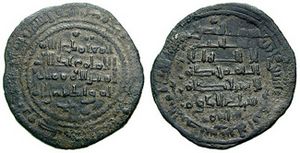Abbadid dynasty facts for kids
The Abbadid dynasty was a powerful Muslim family that ruled a large part of al-Andalus (what is now Spain and Portugal) from about 1023 to 1091. They became very strong after the big Caliphate of Cordoba empire broke apart. The Abbadids were known for their energy and for shaping the time they lived in.
Contents
What Were the Abbadids Like?
The Abbadids loved learning and art. They helped science and medicine grow a lot. They supported smart people and researchers, which made their cities places of great discovery. Many important scientific books were written during their time. One famous book was the Book of Optics by a brilliant scholar named Ibn al-Haytham.
They also cared about Islamic law. They were known for being fair rulers and encouraged using Islamic laws to solve problems. This helped make society in Andalusia stable and peaceful. People across the Muslim world admired their rule.
However, the Abbadids were eventually taken over by another group called the Almoravids. The Almoravids had stricter ideas about Islam. They didn't like how tolerant the Abbadids were of different religions and cultures. This led to a time when creativity and new ideas were not as welcome.
Even though they were overthrown, the Abbadids left a lasting mark. They loved art and amazing buildings. They supported writers and scientists. They also showed tolerance towards different cultures. Their time helped create a rich and diverse society that was admired by many. Their contributions to law helped make Andalusia a fair place. Today, the Abbadids are remembered as an important part of the history of the Iberian Peninsula.
History of the Abbadid Rulers
The Abbadid family came from Egypt and were among the first Arab Muslim families to settle in al-Andalus. They became very important in the city of Seville.
Abu al-Qasim Muhammad ibn Abbad (1023–1042)
Abu al-Qasim Muhammad ibn Abbad was a judge (called a qadi) in Seville. He started the Abbadid dynasty in 1023. His father, Isma'il ibn Abbad, was also an important judge in Seville. Abu al-Qasim was one of the richest men in the city.
He became a leader by helping the people of Seville fight off Berber soldiers who were trying to take over. After the Berbers were gone, the people and nobles asked him to rule. He was careful at first, ruling with advice from a council.
Abu al-Qasim's first big task was to rebuild Seville's army. He offered good pay and allowed people from all backgrounds – Berbers, Arabs, Christians, and even slaves – to join. When a Berber army from Málaga threatened Seville, Abu al-Qasim showed his bravery by offering his own son as a hostage. This made the people trust him completely, and he began to rule alone.
He started to expand his power, making alliances and taking control of nearby areas like Beja and parts of the coast. He even fought against the powerful Taifa of Badajoz. The Berbers continued to be a problem for him. To fight them, Abu al-Qasim found a man who looked like the old caliph Hisham II. He pretended this man was the real caliph, which helped him form a strong alliance with other Muslim states like Cordoba and Valencia. This alliance helped them defeat the Berber leader Yahya. When Abu al-Qasim died in 1042, he had built a state that seemed strong compared to its neighbors.
Abbad II al-Mu'tadid (1042–1069)
Abbad II al-Mu'tadid was Abu al-Qasim's son and took over after him. He was a very interesting and complex ruler. He enjoyed writing poetry and loved literature.
Abbad II was a clever leader, but he was also known for being tricky. He often stayed in his fortified palace, the Alcázar of Seville, and directed his generals from there. In 1053, he tricked several Berber chiefs into visiting him and then captured their kingdoms. He also took over other smaller kingdoms like Mertola and Niebla.
He spent most of his rule trying to make his kingdom bigger by fighting his neighbors, especially the king of Granada. These constant wars weakened the Muslim states, which helped the rising Christian kingdoms of León and Castile. After 1063, King Fernando El Magno of Castile and León attacked Seville and forced Abbad II to pay him tribute.
Muhammad al-Mu'tamid (1069–1095)
Muhammad al-Mu'tamid was the son of Abbad II and the last Abbadid ruler. Like his father, he was a poet and loved supporting other poets. He even chose a poet named Ibn Ammar as his main advisor. However, Ibn Ammar's pride eventually led to his downfall.
Al-Mu'tamid was also greatly influenced by his favorite wife, al-Rumaikiyya. He met her by chance and made her his wife. Many stories tell of her wishes and his efforts to please her.
In 1071, al-Mu'tamid took control of Cordoba. But his power began to weaken. He faced problems with Alfonso VI of Castile and other Christian kingdoms. When Alfonso VI captured Toledo in 1085, al-Mu'tamid made a difficult choice. He asked Yusuf ibn Tashfin, the leader of the Berber Almoravids, for help. He knew the Almoravids might eventually take over his kingdom, but he preferred that to losing al-Andalus to the Christians. He famously said he would rather be a camel-driver in Africa than see his land fall to the Christians.
With the Almoravids' help, they defeated Alfonso in 1086. However, just as al-Mu'tamid had feared, the Almoravids eventually turned on him. In 1091, his kingdom was overthrown by Yusuf ibn Tashfin and his supporters. Al-Mu'tamid was sent away to Morocco.
Al-Mu'tamid's son, Fath al-Mamun, had a daughter named Zaida. She later became connected to King Alfonso VI of Castile.
See also
 In Spanish: Abadí para niños
In Spanish: Abadí para niños


